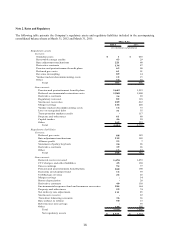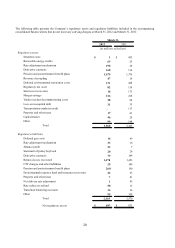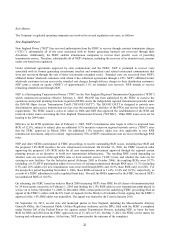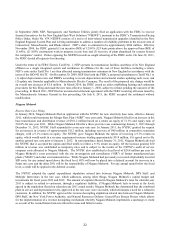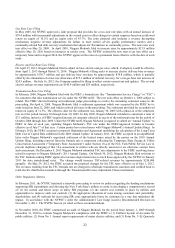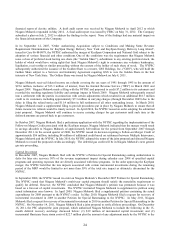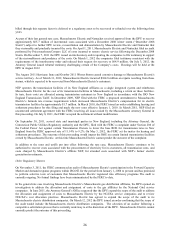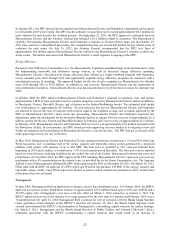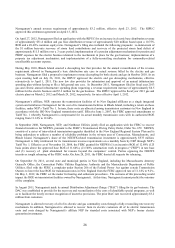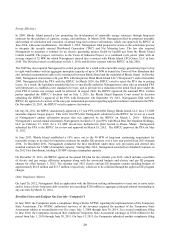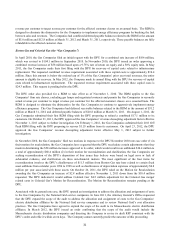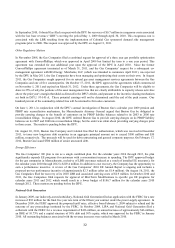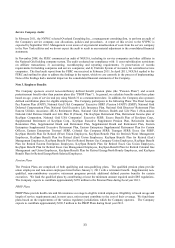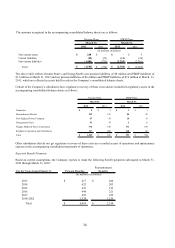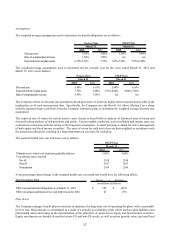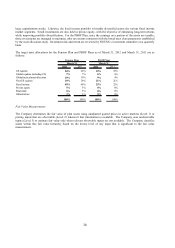National Grid 2012 Annual Report Download - page 29
Download and view the complete annual report
Please find page 29 of the 2012 National Grid annual report below. You can navigate through the pages in the report by either clicking on the pages listed below, or by using the keyword search tool below to find specific information within the annual report.28
Narragansett’ s annual revenue requirement of approximately $3.2 million, effective April 23, 2012. The RIPUC
approved this settlement agreement on April 13, 2012.
On April 27, 2012, Narragansett filed an application with the RIPUC for an increase in electric base distribution revenue
of approximately $31.4 million and gas base distribution revenue of approximately $20 million based upon a 10.75%
ROE and a 49.60% common equity ratio. Narragansett’ s filing also included the following proposals: re-instatement of
the $1 million base-rate recovery of storm fund contributions and recovery of the projected storm fund deficit of
approximately $11.5 million over a 3 years period; implementation of a pension adjustment mechanism for pension and
PBOP expenses for the electric business identical to the mechanism in place for the gas business; implementation of a
property tax adjustment mechanism; and implementation of a fully-reconciling mechanism for commodity-related
uncollectible accounts expense.
During May 2010, Rhode Island enacted a decoupling law that provides for the annual reconciliation of the revenue
requirement allowed in Narragansett’ s base distribution rate case to actual revenue billed by the electric and gas
business. Narragansett filed a proposal to implement revenue decoupling for both electric and gas in October 2010. At an
open meeting held on July 26, 2011, the RIPUC approved the electric and gas decoupling mechanisms, effective
retroactively to April 1, 2011. The new law also provides for submission and approval of an annual infrastructure
spending plan without having to file a full general rate case. In December 2011, Narragansett filed its fiscal year 2013
gas and electric annual infrastructure spending plans requesting a revenue requirement increase of approximately $4.5
million for the electric business and $7.2 million for the gas business. The RIPUC approved the fiscal year 2013 gas and
electric plans on March 2, 2012 and March 29, 2012, respectively, for rates effective April 1, 2012.
Narragansett’ s affiliate, NEP, operates the transmission facilities of its New England affiliates as a single integrated
system and reimburses Narragansett for the cost of its transmission facilities in Rhode Island, including a return on those
facilities, under NEP’ s Tariff No. 1. In turn, these costs are allocated among transmission customers in New England in
accordance with the ISO New England transmission tariff. Effective June 1, 2007, the FERC approved amendments to
Tariff No. 1 whereby Narragansett is compensated for its actual monthly transmission costs with its authorized ROE
ranging from 11.14% to 12.64%.
In September 2008, Narragansett, NEP, and Northeast Utilities jointly filed an application with the FERC to recover
financial incentives for NEEWS, pursuant to the FERC’ s Transmission Pricing Policy Order, Order No. 679. NEEWS,
consists of a series of inter-related transmission upgrades identified in the New England Regional System Plan and is
being undertaken to address a number of reliability problems in the tri-state area of Connecticut, Massachusetts, and
Rhode Island. Narragansett’ s share of the NEEWS-related transmission investment is approximately $575 million.
Narragansett is fully reimbursed for its transmission revenue requirements on a monthly basis by NEP through NEP’ s
Tariff No. 1. Effective as of November 18, 2008, the FERC granted for NEEWS (1) an incentive ROE of 12.89% (125
basis points above the approved base ROE of 11.64%), (2) 100% construction work in progress (“CWIP”) in rate base
and (3) recovery of plant abandoned for reasons beyond the companies’ control. Parties opposing the NEEWS
incentives sought rehearing of the FERC order. On June 28, 2011, the FERC denied all requests for rehearing.
On September 30, 2011, several state and municipal parties in New England, including the Massachusetts Attorney
General's Office, the Connecticut Public Utilities Regulatory Authority and the Massachusetts Department of Public
Utilities, filed with the FERC a complaint under Section 206 of the Federal Power Act against certain Transmission
Owners to lower the base ROE for transmission rates in New England from the FERC approved rate of 11.14% to 9.2%.
On May 3, 2012, the FERC set the matter for hearing and settlement procedures. The outcome of this proceeding would
impact the ROE on transmission facilities owned by Narragansett. At this time, Narragansett cannot predict the outcome
of the complaint.
In August 2011, Narragansett made its annual Distribution Adjustment Charge (“DAC”) filing for its gas business. The
DAC was established to provide for the recovery and reconciliation of the costs of identifiable special programs, as well
as to facilitate the timely revenue recognition of incentive provisions. The prior DAC rate recovered approximately $3.2
million from customers.
Narragansett is allowed recovery of all of its electric and gas commodity costs through a fully reconciling rate recovery
mechanism. In addition, Narragansett is allowed to recover from its electric customers all of its electric transmission
costs and costs charged by Narragansett’ s affiliate NEP for stranded costs associated with NEP’ s former electric
generation investments.


